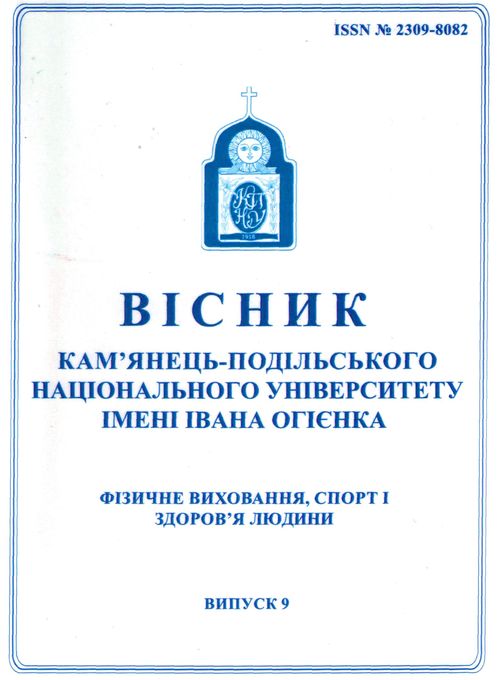ШКІЛЬНИЙ СПОРТ У США ЯК ЗАСІБ ФОРМУВАННЯ ЗАГАЛЬНОЛЮДСЬКОЇ ЦІННОСТІ – ОСВІТИ
DOI:
https://doi.org/10.32626/2309-8082.2016-0.%25pКлючові слова:
шкільний спорт, США, освіта, цінність, формування, засіб.Анотація
Проведена систематизація і аналіз праць науковців США
щодо визначення впливу шкільного спорту на освітні результати
учнів. Встановлено, що завдяки заняттям шкільним спортом в
учнів відбувається розвиток когнітивних вмінь, покращується
класна поведінка, зростають академічні досягнення, формується
позитивне ставлення до навчання, а також вдосконалюються інші
психічні й соціальні компоненти.
Посилання
Всеобщая декларация прав человека [електрон. ресурс] – Режим
доступу до докум.: http://zakon4.rada.gov.ua/laws/show/995_015
Міжнародний пакт про економічні, соціальні і культурні права
[електрон. ресурс] – Режим доступу до докум.: h ttp://zakon4.rada.
gov.ua/laws/show/995_042
Caterino MC. Effects of two types of activity on the performance of
nd, 3rd and 4th grade students on a test of concentration/ Caterino MC.,
Polak ED. // Percept Mot. Skills. – 1999. – № 89. – P. 245-248. – Режим
доступу: http://www.ncbi.nlm.nih.gov/pubmed/10544425
Grissom J.B. Physical fitness and academic achievement / Grissom J. B. // Journal of Exercise Physiology. – 2005. – Vol. 8 № 1. – P. 11-25. – Режим доступу: http://www.nemours.org/content/dam/nemours/www/filebox/
service/preventive/nhps/pep/physfitacadach
DeBate RD. Changes in psychosocial factors and physical activity
frequency among third- to eighthgrade girls who participated in a
developmentally focused youth sport program: a preliminary study /
RD. DeBate [et al.] // Journall School Health.– 2009. – № 79. – P. 474-
Dwyer T. Relation of academic performance to physical activity and
fitness in children/ T. Dwyer [et al.]. // Pediatric Exercise Science. –
– № 13. – P. 225-237.
Field T. Exercise is positively related to adolescents’’ relationships and
academics / T. Field, M. Diego, CE. Sanders // Adolescence. – 2001. –
№ 36. – P. 105-110.
Hawkins R. Athletic investment and academic resilience in a national
sample of African American females and males in the Middle Grades/
Hawkins R., Mulkey LM. // Educ Urban Society. – 2005. – № 38. – P. 62-
Hellison D. Teaching responsibility through physical activity /
Hellison D. -Champaign, IL, Human Kinetics, 1995.– 104 p.
Hillman CH. Be smart, exercise your heart: exercise effects on brain and cognition / CH. Hillman, KI. Erickson, AF. Kramer // Nat Rev Neurosci. – 2008. – № 9. – P. 58-65.
Hillman CH. The effect of acute treadmill walking on cognitive control
and academic achievement in preadolescent children / CH. Hillman
[et al.] // Neuroscience. – 2009. – № 159. – P. 1044-1054.
Hollar D. Effect of a two-year obesity prevention intervention on
percentile changes in body mass index and academic performance in lowincome elementary school children / D. Hollar [et al.] // American Journal of Public Health. – 2010. – P. 646-656. – Режим доступу: http://www.ncbi.nlm.nih.gov/pmc/articles/PMC2836343
Jones-Palm DH. Physical activity and its impact on health behaviour
among youth / DH. Jones-Palm, J. Palm // ICSSPE for World Health
Organisation. – 2004. – Режим доступу: https://www.icsspe.org/sites/
default/files/PhysicalActivity.pdf
Marsh H. School athletic participation: mostly gain with little pain/
H. Marsh, S. Kleitman // Journal Sport Exerc. Psychol. – 2003. – № 25. –
P. 205-228.
Pellegrini AD. Relations between children’’s playground and classroom behavior / AD. Pellegrini, PD. Davis //The British Journal of Educational Psychology. - 1993. - № 63. – P. 88-95.
Pellegrini AD. The effects of recess timing on children’’s classroom and playground behavior / AD. Pellegrini, PD. Huberty, I. Jones // American Educational Research Journal. – 1995. – № 32. – P. 845-864.
Sandford R. It might be fashionable but does it „wor’’? / R. Sandford,
K. Armour, S. Bowyer // Physical activity, behavior management and
impact paper presented at the British Educational Research Association
Annual Conference. – Manchester University. – 2004.
Sandford RA. Re-engaging disaffected youth through physical activity
programmes / RA. Sandford, KM. Armour, PC. Warmington // British
Educational Research Journal. – 2006. – № 32. – P. 251-271.
Shephard RJ. Academic skills and required physical education /
RJ. Shephard [et al.] // The Trois Rivieres Experience. Canadian
Association for Health, Physical Education and Recreation Research
Supplements. – 1994. – № 1. – P. 1-12.
Sibley BA. T he relationship between physical activity and cognition in children: A meta-analysis / BA. Sibley, JL. Etnier // Pediatric Exercise
Science. – 2003. – № 15. – P. 243–256.
Siedentop D . S port e ducation: q uality P E t hrough p ositive s port
experiences / Siedentop D. - Champaign, IL : Human Kinetics, 1994. –
p.
Strong WB. Evidence Based Physical Activity for School-Age Youth /
WB. Strong, RM. Malina, CJR. Blimkie // Pediatr Journal . – 2005. –
№ 146. – P. 732-739.
Tomporowski PD. Effects of acute bouts of exercise on cognition /
Tomporowski PD // Acta Psychologica. – 2003(b). – № 112. – P. 297-324.
Tremblay MS. The Relationship Between Physical Activity, Self-Esteem, and Academic Achievement in 12-Year-Old Children / MS. Tremblay, JW. Inman, JD. Willms // Pediatric Exercise Science. – 2000. – № 12. – P. 312-323.
Trudeau F. Physical education, school physical activity, school sports and academic performance / F. Trudeau, RJ. Shephard // International Journal of Behavioural Nutrition and Physical Activity. – 2008. – № 5. – P. 10.
Trudeau F. Relationships of Physical Activity to Brain Health and
Academic Performance of Schoolchildren / F. Trudeau, RJ. Shephard //
American Journal of Lifestyle Medicine. – 2010. – vol. 4. – № 2. – P. 138-
Welk G. Cardiovascular Fitness and Body Mass Index are Associated with Academic Achievement in Schools / Welk G. – Dallas, Texas: Cooper Institute, 2009.




